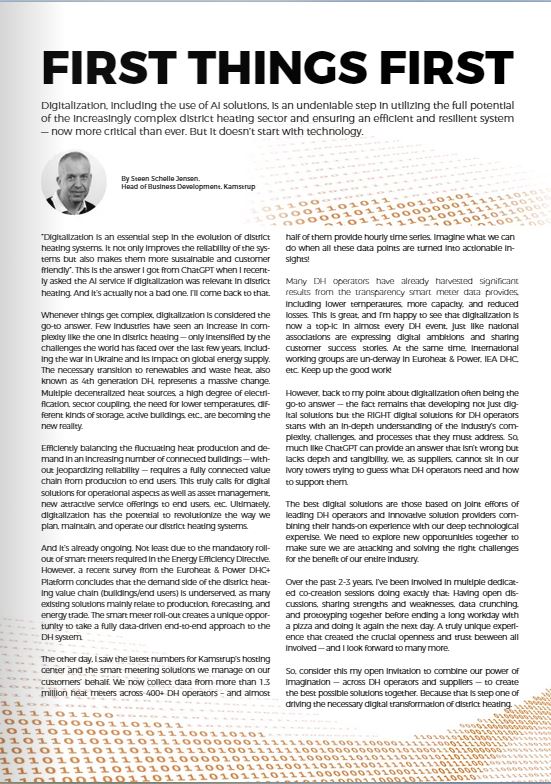Digitalization, including the use of AI solutions, is an undeniable step in utilizing the full potential of the increasingly complex district heating sector and ensuring an efficient and resilient system — now more critical than ever. But it doesn’t start with technology.
By Steen Schelle Jensen, Head of Business Development, Kamstrup
”Digitalization is an essential step in the evolution of district heating systems. It not only improves the reliability of the systems but also makes them more sustainable and customer friendly”. This is the answer I got from ChatGPT, when I recently asked the AI service if digitalization was relevant in district heating. And it’s actually not a bad one. I’ll come back to that.
Whenever things get complex, digitalization is considered the go-to answer. Few industries have seen an increase in complexity like the one in district heating — only intensified by the challenges the world has faced over the last few years, including the war in Ukraine and its impact on global energy supply.
The necessary transition to renewables and waste heat, also known as 4th generation DH, represents a massive change. Multiple decentralized heat sources, a high degree of electrification, sector coupling, the need for lower temperatures, different kinds of storage, active buildings, etc., is becoming the new reality.
Efficiently balancing the fluctuating heat production and demand in an increasing number of connected buildings — without jeopardizing reliability — requires a fully connected value chain from production to end users. This truly calls for digital solutions for operational aspects as well as asset management, new attractive service offerings to end users, etc. Ultimately, digitalization has the potential to revolutionize the way we plan, maintain and operate our district heating systems.
And it’s already ongoing. Not least due to the mandatory roll-out of smart meters required in the Energy Efficiency Directive. However, a recent survey from the Euroheat & Power DHC+ Platform concludes that the demand side of the district heating value chain (buildings/end users) is underserved as many existing solutions mainly relate to production, forecasting and energy trade. The smart meter roll-out creates a unique opportunity to take a fully data-driven end-to-end approach to the DH system.
The other day, I saw the latest numbers for Kamstrup’s hosting center and the smart metering solutions we manage on our customers’ behalf. We now collect data from more than 1.3 million heat meters across 400+ DH operators – and almost half of them provide hourly time series. Imagine what we can do when all these data points are turned into actionable insights!
Many DH operators have already harvested significant results from the transparency smart meter data provides, including lower temperatures, more capacity, reduced losses. This is great and I’m happy to see that digitalization is now a topic in almost every DH event, just like national associations are expressing digital ambitions and sharing customer success stories while international working groups are underway in Euroheat & Power, IEA DHC, etc. Keep up the good work!
However, back to my point about digitalization often being the go-to answer — the fact remains that developing not just digital solutions, but the RIGHT digital solutions for DH operators starts with an in-depth understanding of the industry’s complexity, the challenges and processes they must address.
So, much like ChatGPT can provide an answer that isn’t wrong but lacks depth and tangibility, we as suppliers cannot sit in our ivory towers trying to guess what DH operators need and how to support them.
The best digital solutions are those based on joint efforts of leading DH operators and innovative solutions providers – combining their hands-on experience with our deep technological expertise. We need to explore the new opportunities together to make sure we are attacking and solving the right challenges for the benefit of our entire industry.
Over the past 2-3 years, I’ve been involved in multiple dedicated co-creation sessions doing exactly that. Having open discussions, sharing strengths and weaknesses, data crunching and prototyping together before ending a long workday with a pizza and doing it again the next day. A truly unique experience that created the crucial openness and trust between all involved — and I look forward to many more.
So, consider this my open invitation to combine our power of imagination — across DH operators and suppliers — to create the best possible solutions together. Because that is step one of driving the necessary digital transformation of district heating.


